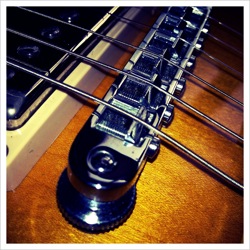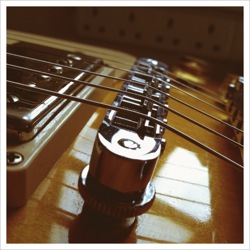Tun-O-Matic Turnabout
 Gibson does things Gibson's way.
Whether it makes sense or not.
Gibson does things Gibson's way.
Whether it makes sense or not.
Anybody who works with guitars could, most likely, give you a list of 'quirks' that help keep Gibson's guitars traditional. For 'traditional', you can sometimes read, "stuff that doesn't make sense but it's the way we've done it for decades so we'd be mental to change".
The saddles on the usual Les Paul bridge—the Gibson Tun-O-Matic—are individually adjustable so that each string can be tweaked to help intonate the guitar (to allow it play mostly in tune over the length of the neck). The bridge is installed at an angle to provide some extra backwards travel to get things where they need to be.
All seemingly reasonable.
There are two type of bridge generally fitted to Les Pauls (and most Gibson electrics): The ABR-1 and the Nashville. The ABR is the original and, if you've ever paid it any attention, you'll probably have seen that it has the three bass-side saddles installed backwards (that is, with the sloped/angled side towards the pickups)*. If you think about it, this isn't the best way to have a string contact a bridge—ideally, you want a clean, definite take-off point like you'd get with a straight edge, as on the treble strings.
So, why this craziness?
Basically, it's to make up for the fact that there is insufficient travel on the ABR bridge to properly add the compensation the wound strings need. Flipping the saddles allows a little bit more compensation before the saddle can't go any farther.
Now, to be fair, Gibson tried to address this issue (and others) with the ABR when they developed the Nashville Tune-O-Matic. And, just like when Gibson change anything, many people think that the original was best. Of course, I have an opinion on this but it's not really the point here, so I won't go into it. Suffice it to say, the Nashville bridge has a bit more travel for its saddles and so, it usually intonates reasonably well.
 Sometimes though, it doesn't.
Sometimes though, it doesn't.
Sometimes, you need to do the ABR trick and flip a saddle. Good intonation takes precedent over any drawbacks associated with the backward saddles.
Not all Nashvilles are created equal when it comes to doing this. It tends to be easy on a Gibson bridge (just back the screw out until it disengages) but some aftermarket bridges are a bit more hassle.
Incidentally, the ABR-style bridge (with the already-reversed saddles) sometimes requires one or more saddle-flips too. A lot depends on factors like string-gauge and even whether the bridge has been installed slightly out of place (it happens). Saddle-flipping on an ABR-1 is really simple—pop out the retainer wire and lift out the saddle. Easy-peasy.
Perhaps I can make this the first in a series of Things That Are A Bit Mental About Gibson Guitars.
*Incidentally, occasionally, more or less than three saddles is reversed. It depends on how the particular guitar intonates.
